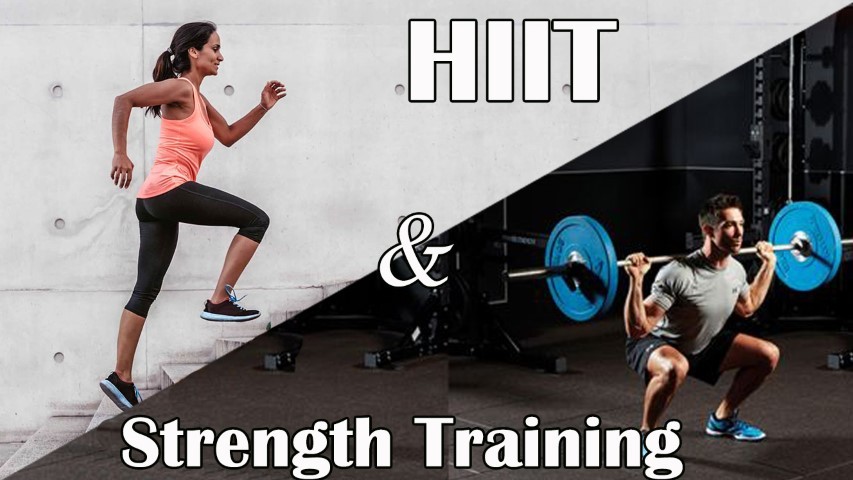
HIIT and Strength Training
HIIT and Strength Training – Should You Do Both?
With a seemingly endless list of workout types to do, it’s tough to decide where to focus your time and efforts. Choosing for yourself is difficult, but if you’re a trainer you must also guide clients.
Two popular types of workouts both have benefits: HIIT and strength training. You don’t have to choose one or the other, and in fact, these two workouts complement each other well. Do them separately or in combination for maximum fat loss, strength gains, and cardiovascular fitness.
HIIT and Strength Training – A Comparison
There are so many types of workouts available for the typical gym-goer, but there are two that are both popular and effective. They both help improve overall health, build strength, reduce body fat, and lose or maintain weight.
High-Intensity Interval Training (HIIT). HIIT workouts alternate between intense, short bouts and recovery or low-intensity periods. The idea is to get the heart rate up very high, recover slightly, and then do it again. For example, you might sprint 200 meters at the track, jog 200, and repeat for 10 or 12 reps.
Strength Training. This is a broad category of workout that focuses on building muscle strength and/or size. Lifting weights, using resistance bands, bodybuilding, bodyweight exercises, and using weight machines all count as strength training.
Both types of workouts have benefits. And they can each be scaled up or down for ability level and to progress.
Benefits of HIIT Workouts
HIIT workouts are cardio-focused, which means they benefit heart and cardiovascular health. Compared to traditional cardio workouts performed at a steadier effort level and heart rate, HIIT has a lot of benefits:
- Improves both aerobic and anaerobic fitness
- Lowers insulin resistance and improves glucose tolerance
- Burns calories
- Results in significant fat loss
- HIIT can be a great workout, but there are some risks too. Check out this post to find out how to do HIIT safely and when to skip it.
- Benefits of Strength Training
Strength training also has its benefits, many that overlap with HIIT. It increases muscle mass, and slows muscle loss that accompanies aging; it improves bone density and joint flexibility; strength training reduces injuries.
Research also shows that strength training is a powerful way to lose weight, maintain a healthy weight, and lose fat, especially compared with steady-state cardio.
Don’t let your female clients get away with skipping weights. Women and men both benefit from strength training.
The Best of Both Worlds – Do HIIT and Strength Training for Best Results
For optimal health benefits from working out, you need both cardio and strength training. And with the added benefits of HIIT cardio, doing both provides the most advantages.
Especially if you or a client want to lose body fat and focus on weight loss, use both types of workouts. Studies show that the combination of strength training and cardio in an exercise routine maximizes fat loss and healthy weight.
Doing HIIT and Strength Workouts Separately
There are two ways to get both HIIT and strength training into your routine. Either complete them separately or combine them. You may want to separate these two workouts if you have the time in your schedule to maximize the results of each individually.
Can You Do HIIT And Strength Training on The Same Day?
Certainly, but there are some caveats. HIIT workouts are tough on the body, so for most people, it’s better to do these workouts on separate days. However, if you are already highly-trained, you can probably handle it.
When doing both in the same day, keep the HIIT workout strictly cardio so that you’re not overtaxing the muscles. A sprint workout or using an elliptical machine or spin bike works well for a true cardio HIIT workout.
The order in which you do the two workouts separately is not important. If you prefer to do cardio on Tuesdays and strength on Wednesdays, or vice versa, that’s fine. If you like weights in the morning and cardio in the evenings, make that your routine.
Time-Saver: Combining HIIT and Strength
You can combine HIIT with strength training, and research suggests there may be some good reasons to do so. A study compared participants doing high-intensity and medium-intensity resistance workouts. A few important results put the HIIT participants ahead:
They had more significant strength improvements in more of the ten exercises used for the study.
The medium-intensity group saw zero improvements in some of the exercises, while the HIIT group improved in all.
Both groups had significant fat loss.
The HIIT group had greater improvements in health measures, like blood pressure.
These benefits, plus saving time make a HIIT strength workout pretty appealing.
Adding Weights to a HIIT Workout
There are two ways to approach a combo workout: take your usual strength session and turn it into a HIIT workout or start with a HIIT workout and add weights. There isn’t necessarily a better strategy, so do what works for you or your client.
For those who focus more on cardio, start with a standard HIIT workout and add in elements of strength training. One way to do this is to do some strength moves during the recovery periods. For instance, follow an intense interval of burpees with a set of bent over rows or triceps dips.
Another option is to weight your HIIT moves. A plyo HIIT workout is ideal for this. Box jumps, squat jumps, jumping lunges, and other plyometric moves make a great HIIT workout because they rev up the heart. Add weights, safely and a little bit at a time, to these moves for more strength training.
Turning a Strength Workout into a HIIT Workout
If you already spend most of your time on lifting or other strength training workouts, it may be easier to make some adjustments to turn one or two sessions per week into HIIT plus strength. Here are some things you can do to make it an easy transition:
Shorten rest periods. When you workout for HIIT the goal is to get your heart rate seriously elevated. One way you can get the same effect with weights is to take less time to rest in between sets.
Add in more compound movements. For your HIIT-strength days, focus on compound movements that work entire large muscle groups. Think lunges and pushup instead of lat pull downs and biceps curls.
Add cardio. Take some of your strength movements to the next level with cardio moves. This will ensure you get the muscle training but also raise your heart rate. Plyo moves are great for this, like squat jumps and jumping lunges.
Increase the weights. Heavy lifting is important for major strength gains, but it also increases your heart rate. Use bigger weights and fewer reps for a HIIT session.
HIIT and strength training are both effective workouts for a number of fitness and health measures. Include both in your routine safely and without overdoing it. Stick with no more than two HIIT workouts per week of any type, and if your body feels burned out, take a day off or dial back the intensity.
Here at NutriFit Health our ISSA Certified Personal Trainer will show you how to properly perform HIIT in conjunction with Weight Training.



